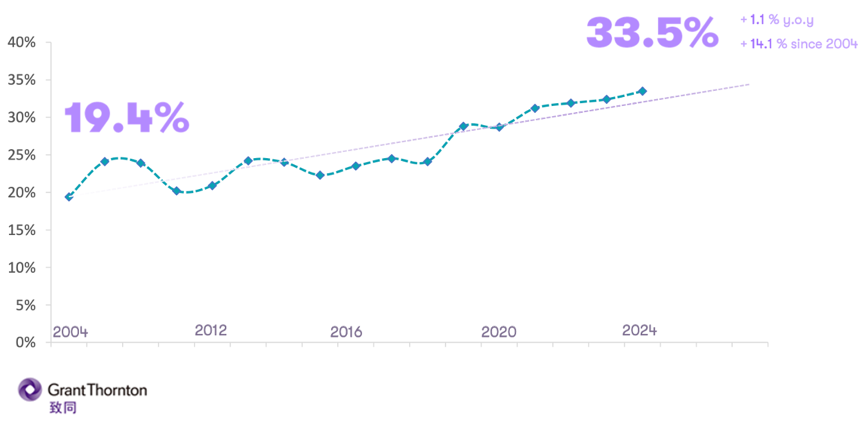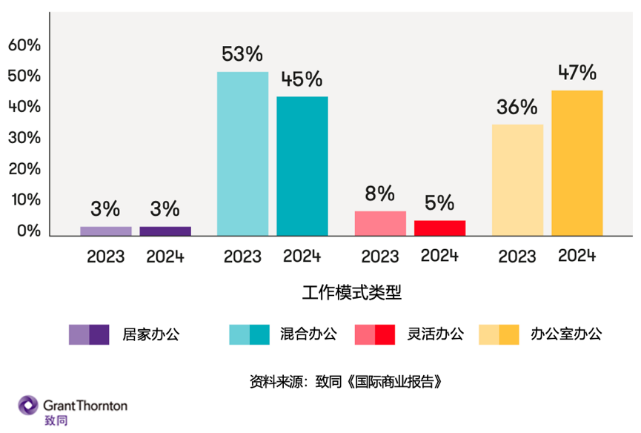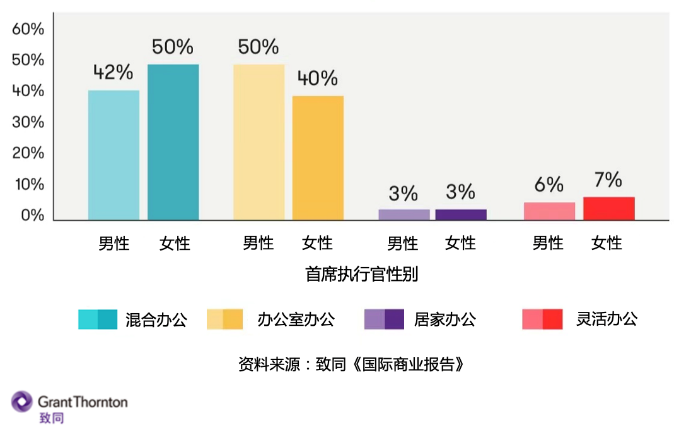Grant Thornton’s latest report surveyed approximately 5,000 mid-market businesses* in 28 countries between October and December 2023 to track the global progress of women in senior management. The report reveals that the percentage of women in senior management roles globally has increased from 19.4% to 33.5% over two decades. The proportion of female executives has only increased by 1.1% in the past year, indicating a slowdown in growth over the past three years. Asia-Pacific region has seen regression in fostering gender diversity, with female leaders accounting for 31% in 2024, down from 32% in 2023, which trails behind other major regions. Latin America leads with 36% of senior management positions held by women. In China, the proportion of female executives is 33%, outperforming the Asia-Pacific average.
Slow growth in proportion of female executives in the global mid-market, with regression in Asia-Pacific
This year marks the 20th year of Grant Thornton’s work in monitoring and measuring the proportion of women occupying senior management roles in mid-market companies around the world. The percentage of women in senior management roles has increased by 14.1% globally over two decades. However, progress remains disappointingly slow with just a 1.1 percentage point increase from last year. Without further action from businesses to support women in senior leadership, gender parity in senior management will not be achieved until 2053 at the current pace.

The report reveals that the Asia-Pacific region has seen regression in fostering gender diversity under the constraints of multiple factors such as the epidemic. This year, the percentage of female CEOs dropped significantly from 28% to 19% compared to last year. The Asia-Pacific region still has the lowest percentage of female executives. This is due to the influence of developed countries in the region, and it is significantly behind the rest of the region. The proportion of female executives decreased from 32% in 2023 to 31% in 2024.
While APAC underperformed the global benchmark, significant country-by-country variation exists within the region.
The proportion of female executives in Chinese companies in 2024 reached 33%, exceeding the Asia-Pacific average, although it was two percentage points lower than the previous year. Additionally, only 2% of Chinese companies have no female executives, which is significantly lower than the Asia-Pacific region's 9% and the global figure of 7%. China has made positive progress in improving gender equality in enterprises.
Li Huiqi, CEO of Grant Thornton China, stated that although there has been an increase in the global discussion on gender equality, progress has been slow. Enterprises must take concrete and effective measures at every level, from high-level strategy to daily practices, to push for parity and build a more diverse, equal, and inclusive working environment.
Return-to-office trend following the pandemic would impede progress towards gender equity, and there are three main pathways to hasten progress
In the past year, global mid-market firms have witnessed a significant return to office-based work. Presently, 47% of businesses operate primarily from the office, up from 36% the previous year. In comparison, 45% have adopted a hybrid model, down from 53% last year. The potential driver behind this situation is male CEOs, as 50% of businesses led by men are mainly office-based, in contrast to 40% of businesses led by women.
The freedom to choose a work location provides substantial advantages for women in business, impacting not only those in senior positions but also contributing to the development of the talent pipeline. Flexibility is crucial for retaining and advancing women in the workplace.


The report proposes three pathways that can speed up the attainment of gender equality in businesses. These include: appointing both a senior leader and a female senior leader to lead Diversity, Equity, and Inclusion (DE&I) efforts, establishing a dedicated DE&I strategy with regular reviews to ensure its effectiveness in increasing the percentage of women in senior management roles, and reassessing decisions related to the workforce’s return-to-office arrangement.
Sue Cheng, Partner of People & Culture at Grant Thornton China, suggests that mid-market companies have the flexibility to drive significant change. Cheng encourages these companies to proactively develop a DE&I strategy that aligns with their business objectives and integrates fully into their organizational culture and values. Increasing the proportion of female executives is not only a moral imperative but also beneficial for the business's economics.
According to a report from the World Bank, closing economic gender gaps could unlock a 'gender dividend' of $172 trillion for the global economy.
Peter Bodin, CEO of GTIL, says: “Our Women in Business research has been a significant contributor to the global debate on equity in the workplace for 20 years. While we’ve seen some positive change over that time, we also know that sustainable change takes an intentional effort and clear accountability from leadership at every organisation.
Through the Grant Thornton International Business Report research and the pathways we identify, we aim to give mid-market organisations a roadmap to accelerate progress and build more diverse, resilient and successful businesses."
[100004], 5th Floor, Scitech Palace 22 Jianguomen Wai Avenue, Chaoyang District, Beijing
LocationTag with












